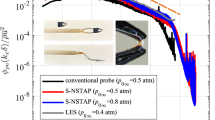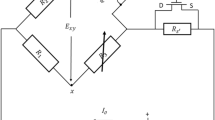Abstract
A new nanoscale thermal anemometry probe (NSTAP) was designed and fabricated to measure mass flux in supersonic flows. This sensor was evaluated in the Trisonic Wind Tunnel Munich (TWM) at both subsonic and supersonic speeds. Subsonic compressible flow tests were performed to confirm the new sensor’s repeatability and to compare its behaviour to measurements from a conventional cylindrical hot-wire, while supersonic tests were performed to investigate the nature of the convective heat transfer from the nanoscale sensor at those conditions. For the range of mass fluxes tested in the supersonic regime, a linear relationship between the Nusselt number and the Reynolds number fit the data well. A linear relationship has previously been noticed at length scales close to the molecular mean free path of the flow and has been attributed to the free-molecule flow regime, where the Knudsen number is on the order of unity.
Graphical abstract











Similar content being viewed by others
References
Bailey SCC, Kunkel GJ, Hultmark M, Vallikivi M, Hill JP, Meyer KA, Tsay C, Arnold CB, Smits AJ (2010) Turbulence measurements using a nanoscale thermal anemometry probe. J Fluid Mech 663:160–179
Bruun HH (1996) Hot-wire anemometry: principles and signal analysis
Byers CP (2018) Theoretical and experimental investigations of similarity solutions in turbulent flows. PhD thesis, Princeton University
Comte-Bellot G (1976) Hot-wire anemometry. Annu Rev Fluid Mech 8(1):209–231
Dewey CF Jr (1965) A correlation of convective heat transfer and recovery temperature data for cylinders in compressible flow. Int J Heat Mass Transfer 8(2):245–252
Fan Y, Arwatz G, Van Buren T, Hoffman D, Hultmark M (2015) Nanoscale sensing devices for turbulence measurements. Exp Fluids 56(7):138
Hultmark M, Ashok A, Smits AJ (2011) A new criterion for end-conduction effects in hot-wire anemometry. Meas Sci Technol 22(5):055401
Hultmark M, Vallikivi M, Bailey SCC, Smits AJ (2012) Turbulent pipe flow at extreme Reynolds numbers. Phys Rev Lett 108(9):094501
Hutchins N, Monty JP, Hultmark M, Smits AJ (2015) A direct measure of the frequency response of hot-wire anemometers: temporal resolution issues in wall-bounded turbulence. Exp Fluids 56(1):18
King LV (1914) XII. On the convection of heat from small cylinders in a stream of fluid: Determination of the convection constants of small platinum wires with applications to hot-wire anemometry. Phil Trans R Soc Lond A 214(509–522):373–432
Kovasznay LS (1950) The hot-wire anemometer in supersonic flow. J Aeronaut Sci 17(9):565–572
Kovasznay LS (1953) Turbulence in supersonic flow. J Aeronaut Sci 20(10):657–674
Laufer J, McClellan R (1956) Measurements of heat transfer from fine wires in supersonic flows. J Fluid Mech 1(3):276–289
Li JD, McKeon BJ, Jiang W, Morrison JF, Smits AJ (2004) The response of hot wires in high Reynolds-number turbulent pipe flow. Meas Sci Technol 15(5):789
Morkovin MV (1956) Fluctuations and hot-wire anemometry in compressible flows. North Atlantic Treaty Organization Advisory Group for Aeronautical Research and Development
Oppenheim A (1953) Generalized theory of convective heat transfer in a free-molecule flow. J Aeronaut Sci 20(1):49–58
Raffel M, Willert CE, Scarano F, Kähler CJ, Wereley ST, Kompenhans J (2018) Particle image velocimetry: a practical guide. Springer, New York
Rapp BE (2016) Microfluidics: modeling, mechanics and mathematics. William Andrew, Amsterdam
Sarma GR (1993) Analysis of a constant voltage anemometer circuit. In: 1993 IEEE instrumentation and measurement technology conference, IEEE, pp 731–736
Scharnowski S, Bross M, Kähler CJ (2019) Accurate turbulence level estimations using PIV/PTV. Exp Fluids 60(1):1
Sheplak M, Spina EF, McGinley CB (1996) Progress in hot-film anemometry for hypersonic flow. Exp Thermal Fluid Sci 13(1):21–28
Smits AJ, Hayakawa K, Muck KC (1983) Constant temperature hot-wire anemometer practice in supersonic flows. Exp Fluids 1(2):83–92
Stalder JR, Goodwin G, Creager MO (1951) A comparison of theory and experiment for high-speed free-molecule flow
Stalder JR, Goodwin G, Creager MO (1952) Heat transfer to bodies in a high-speed rarified-gas stream
Vallikivi M, Smits AJ (2014) Fabrication and characterization of a novel nanoscale thermal anemometry probe. J Microelectromech Syst 23(4):899–907
Vallikivi M, Hultmark M, Bailey SCC, Smits AJ (2011) Turbulence measurements in pipe flow using a nano-scale thermal anemometry probe. Exp Fluids 51(6):1521–1527
Wallace JM, Foss JF (1995) The measurement of vorticity in turbulent flows. Annu Rev Fluid Mech 27(1):469–514
Wittmer KS, Devenport WJ, Zsoldos JS (1998) A four-sensor hot-wire probe system for three-component velocity measurement. Exp Fluids 24(5–6):416–423
Acknowledgements
This work was supported by the AFOSR FA9550-16-1-0170 (program manager: Ivett Leyva) and by the German Research Foundation (DFG). This work was also partly supported by the DFG Priority Programme SPP 1881 Turbulent Superstructures project number KA1808/21-1. The authors are grateful for having participated in the Sonderforschungsbereich Transregio 40 program as this initiated collaboration between both institutions. The authors particularly thank Dr. Christian Stemmer for his support throughout the program. The authors are also grateful to Princeton University’s clean room staff for their advice regarding certain manufacturing processes. In particular, the authors thank David S. Barth for his assistance using the scanning electron microscope. Finally, the authors thank Prof. Alexander J. Smits for his helpful discussions.
Author information
Authors and Affiliations
Corresponding author
Additional information
Publisher's Note
Springer Nature remains neutral with regard to jurisdictional claims in published maps and institutional affiliations.
Rights and permissions
About this article
Cite this article
Kokmanian, K., Scharnowski, S., Bross, M. et al. Development of a nanoscale hot-wire probe for supersonic flow applications. Exp Fluids 60, 150 (2019). https://doi.org/10.1007/s00348-019-2797-z
Received:
Revised:
Accepted:
Published:
DOI: https://doi.org/10.1007/s00348-019-2797-z




